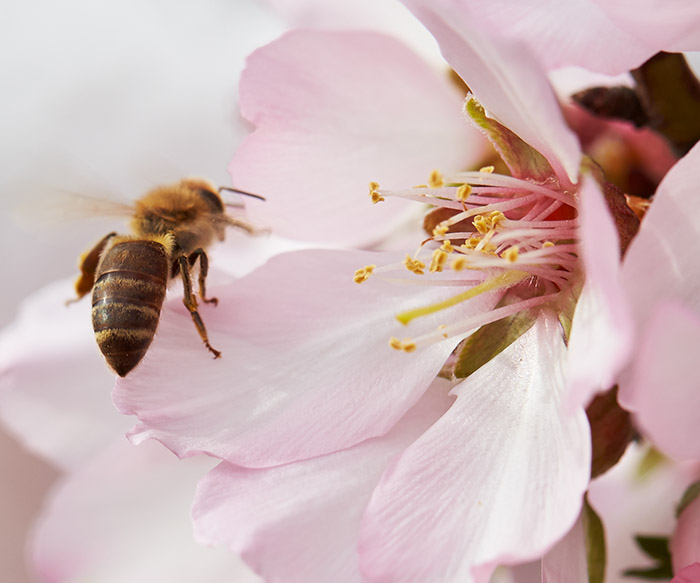During bloom, as many as 30 billion honey bees1 buzz from tree to tree in California almond orchards. Protecting their health during this busy time of year is imperative for the industry, and the aim to maintain honey bee health was one of the driving forces behind the Almond Board of California’s (ABC’s) update of the Honey Bee Best Management Practices (created in 2014) last year.
 These guidelines – created with input from beekeepers, researchers, regulators and the almond community – provide growers with simple, practical steps that they, along with beekeepers and other pollination stakeholders, can take to protect and promote bee health in and around their orchards.
These guidelines – created with input from beekeepers, researchers, regulators and the almond community – provide growers with simple, practical steps that they, along with beekeepers and other pollination stakeholders, can take to protect and promote bee health in and around their orchards.
Now, a survey developed by university researchers in California and North Carolina intends to measure the overall awareness and application of the BMPs.
The survey will collect baseline data about which bee-friendly practices growers have adopted in their orchards, the barriers to implementing the BMP’s recommendations and what incentives – reduced hive rental costs, tax breaks, a price premium from handlers, etc. – may drive broader adoption of bee-friendly procedures among growers.
The survey asks a series of questions about orchard management practices, including whether growers are aware of and follow the BMPs, whether they have planted cover crops, how knowledgeable they are about permanent pollinator management practices (hedgerows, perennial or reseeding wildflower strips, riparian forests and filter strips) and whether they would participate in a voluntary bee-friendly certification program, requiring them to adopt some level of bee-friendly management practices to qualify.
The online survey is being conducted by Dr. Jennie Durant of UC Riverside and Emily McNamara of Duke University. The Almond Board of California encourages growers to participate in the short survey as it will not only help inform what ABC can do to further support growers but also provide insight for others in the almond value chain who are interested in supporting bee health.
Growers can click here to complete the online survey, which should take less than 15 minutes.
“For ABC, it’s a chance to learn more about some of the challenges growers face,” said Josette Lewis, the Almond Board’s director of Agricultural Affairs. “Our goal is to learn what could be done to improve adoption of the BMPs above and beyond what growers are already doing.”
ABC’s Honey Bee BMPs lay out a series of steps growers, pesticide applicators and beekeepers should implement to protect honey bees in and around almond orchards. Among the key points in the BMPs, which the survey also includes, are the following:
- All stakeholders should regularly communicate about pest control decisions. Beekeepers should be contacted 48 hours before any pesticide application.
- Before bloom, all parties should agree on a pesticide plan that outlines which pest control materials may be used.
- Beekeepers should register their hives through the BeeWhere program by Jan. 1 and update hive location information when hives are moved.
- Growers should avoid applying pesticides during bloom. Any fungicide application required during bloom should occur in late afternoon or evening, when bees and pollen are not present.
- Growers should avoid tank-mixing products (i.e., combining more than one formulated product or adding adjuvants) during bloom.
- Beekeepers and growers should establish who is responsible for providing clean water in the orchard for bees and who will replace the water after any pesticide application.
In addition to their adoption of the BMPs, the survey also asks growers whether they have planted cover crops in the past, like those offered via the Seeds for Bees program through Project Apis m. Cover crops provide an additional food source for bees while also increasing the soil’s structure and water retention. About 150 growers – representing about 8,000 acres in the state – participated in the 2018-19 program, according to Project Apis m.
Lewis acknowledged that covers crops – though proven to be good for bees and the soil – require extra work from growers.
“The almond industry has been recognized for the progress it has made in protecting bee health,” said Lewis, “but there is more work to be done to show agriculture can be part of a healthy environment. It is important that growers do all they can to promote bee health in their orchards to demonstrate their commitment to sustainably growing quality almonds.”
[1] AgNet West, “BeeSafe Program Working in Tandem with BeeWhere Program,” May 27, 2019